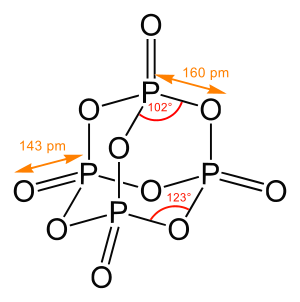Achemical structureof amoleculeis a spatial arrangement of itsatomsand their chemical bonds. Its determination includes achemist's specifying themolecular geometryand, when feasible and necessary, theelectronic structureof the target molecule or other solid. Molecular geometry refers to the spatial arrangement ofatomsin amoleculeand thechemical bondsthat hold the atoms together and can be represented usingstructural formulaeand bymolecular models;[1]complete electronic structure descriptions include specifying the occupation of a molecule'smolecular orbitals.[2][3]Structure determination can be applied to a range of targets from very simple molecules (e.g.,diatomicoxygenornitrogen) to very complex ones (e.g., such asproteinorDNA).

Background
editTheories of chemical structure were first developed byAugust Kekulé,Archibald Scott Couper,andAleksandr Butlerov,among others, from about 1858.[4]These theories were first to state that chemical compounds are not a random cluster of atoms and functional groups, but rather had a definite order defined by thevalencyof theatomscomposing the molecule, giving the molecules a three dimensional structure that could be determined or solved.
Concerning chemical structure, one has to distinguish between pure connectivity of the atoms within a molecule (chemical constitution), a description of a three-dimensional arrangement (molecular configuration,includes e.g. information onchirality) and the precise determination of bond lengths, angles and torsion angles, i.e. a full representation of the (relative) atomic coordinates.
In determining structures ofchemical compounds,one generally aims to obtain, first and minimally, the pattern and degree of bonding between all atoms in the molecule; when possible, one seeks the three dimensional spatial coordinates of the atoms in the molecule (or other solid).[5]
Structural elucidation
editThe methods by which one can determine the structure of a molecule is calledstructural elucidation.These methods include:
- concerning only connectivity of the atoms:spectroscopiessuch asnuclear magnetic resonance(protonandcarbon-13 NMR), various methods ofmass spectrometry(to give overall molecular mass, as well as fragment masses).Techniques such asabsorption spectroscopyand thevibrational spectroscopies,infraredandRaman,provide, respectively, important supporting information about the numbers and adjacencies of multiple bonds, and about the types of functional groups (whose internal bonding gives vibrational signatures); further inferential studies that give insight into the contributing electronic structure of molecules includecyclic voltammetryandX-ray photoelectron spectroscopy.
- concerning precise metric three-dimensional information: can be obtained for gases bygas electron diffractionandmicrowave (rotational) spectroscopy(and other rotationally resolved spectroscopy) and for the crystalline solid state byX-ray crystallography[6]or neutron diffraction.These technique can produce three-dimensional models at atomic-scaleresolution,typically to a precision of 0.001 Å for distances and 0.1° for angles (in unusual cases even better).[7][6]
Additional sources of information are: When a molecule has an unpaired electron spin in afunctional groupof its structure,ENDORandelectron-spin resonancespectroscopes may also be performed. These latter techniques become all the more important when the molecules contain metal atoms, and when the crystals required by crystallography or the specific atom types that are required by NMR are unavailable to exploit in the structure determination. Finally, more specialized methods such aselectron microscopyare also applicable in some cases.
See also
edit- Structural chemistry
- Chemical structure diagram
- Crystallographic database
- MOGADOCA data base for experimental structures determined in the gas phase
- Pauli exclusion principle
- Chemical graph generator
References
edit- ^Haaland, Arne (2008).Molecules and Models: The Molecular Structures of Main Group Element Compounds.Oxford: Oxford University Press.ISBN978-0-19-923535-3.OCLC173809048.
- ^Weinhold, Frank; Landis, Clark R. (2005).Valency and Bonding: A Natural Bond Orbital Donor-Acceptor Perspective.Cambridge, UK: Cambridge University Press.ISBN0-521-83128-8.OCLC59712377.
- ^Gillespie, Ronald J.; Popelier, Paul L. A. (2001).Chemical Bonding and Molecular Geometry: From Lewis to Electron Densities.New York: Oxford University Press.ISBN0-19-510495-1.OCLC43552798.
- ^36th congress of the German physicians and scientists 1861
- ^Wells, A. F. (Alexander Frank), 1912- (July 12, 2012).Structural inorganic chemistry(Fifth ed.). Oxford.ISBN978-0-19-965763-6.OCLC801026482.
{{cite book}}:CS1 maint: location missing publisher (link) CS1 maint: multiple names: authors list (link) CS1 maint: numeric names: authors list (link) - ^abRankin, David W. H. (January 2, 2013).Structural methods in molecular inorganic chemistry.Morrison, Carole A., 1972-, Mitzel, Norbert W., 1966-. Chichester, West Sussex, United Kingdom.ISBN978-1-118-46288-1.OCLC810442747.
{{cite book}}:CS1 maint: location missing publisher (link) - ^Glusker, Jenny Pickworth. (1994).Crystal structure analysis for chemists and biologists.Lewis, Mitchell., Rossi, Miriam. New York: VCH.ISBN0-89573-273-4.OCLC25412161.
Further reading
edit- Gallagher, Warren (2006). "Lecture 7: Structure Determination by X-ray Crystallography".Chem 406: Biophysical Chemistry(PDF)(self-published course notes). Eau Claire, WI, USA: University of Wisconsin-Eau Claire, Department of Chemistry.RetrievedJuly 2,2014.
- Ward, S. C.; Lightfoot, M. P.; Bruno, I. J.; Groom, C. R. (April 1, 2016)."The Cambridge Structural Database".Acta Crystallographica Section B.72(2): 171–179.doi:10.1107/S2052520616003954.ISSN2052-5206.PMC4822653.PMID27048719.